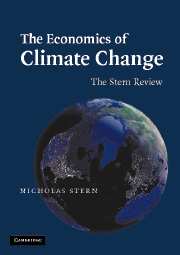Book contents
- Frontmatter
- Contents
- Preface
- Acknowledgements
- Introduction
- Summary of Conclusions
- Part I Climate Change – Our Approach
- Part II Impacts of Climate Change on Growth and Development
- Part III The Economics of Stabilisation
- Part IV Policy Responses for Mitigation
- Part V Policy Responses for Adaptation
- Part VI International Collective Action
- 21 Framework for Understanding International Collective Action for Climate Change
- 22 Creating a Global Price for Carbon
- 23 Supporting the Transition to a Low-Carbon Global Economy
- 24 Promoting Effective International Technology Co-operation
- 25 Reversing Emissions from Land Use Change
- 26 International Support for Adaptation
- 27 Conclusions: Building and Sustaining International Co-operation on Climate Change
- Abbreviations and Acronyms
- Postscript
- Technical Annex to Postscript
- Index
25 - Reversing Emissions from Land Use Change
Published online by Cambridge University Press: 05 March 2014
- Frontmatter
- Contents
- Preface
- Acknowledgements
- Introduction
- Summary of Conclusions
- Part I Climate Change – Our Approach
- Part II Impacts of Climate Change on Growth and Development
- Part III The Economics of Stabilisation
- Part IV Policy Responses for Mitigation
- Part V Policy Responses for Adaptation
- Part VI International Collective Action
- 21 Framework for Understanding International Collective Action for Climate Change
- 22 Creating a Global Price for Carbon
- 23 Supporting the Transition to a Low-Carbon Global Economy
- 24 Promoting Effective International Technology Co-operation
- 25 Reversing Emissions from Land Use Change
- 26 International Support for Adaptation
- 27 Conclusions: Building and Sustaining International Co-operation on Climate Change
- Abbreviations and Acronyms
- Postscript
- Technical Annex to Postscript
- Index
Summary
KEY MESSAGES
Curbing deforestation is a highly cost-effective way of reducing greenhouse gas emissions and has the potential to offer significant reductions fairly quickly. It also helps preserve biodiversity and protect soil and water quality. Encouraging new forests, and enhancing the potential of soils to store carbon, offer further opportunities to reverse emissions from land use change.
Policies on deforestation should be shaped and led by the nation where the forests stand but there should be strong help from the international community, which benefits from their actions.
At a national level, establishing and enforcing clear property rights to forestland, and determining the rights and responsibilities of landowners, communities and loggers, is key to effective forest management. This should involve local communities, and take account of their interests and social structures, work with development goals and reinforce the process of protecting the forests.
Compensation from the international community should be provided and take account of the opportunity costs of alternative uses of the land, the costs of administering and enforcing protection, and managing the transition. Research carried out for this report indicates that the opportunity cost of forest protection in 8 countries responsible for 70 per cent of emissions from land use could be around $5 billion annually, initially, although over time marginal costs would rise.
Carbon markets could play an important role in providing such incentives in the longer term. But there are short-term risks of de-stabilising the crucial process of building strong carbon markets if deforestation is integrated without agreements that increase demand for emissions reductions, and an understanding of the scale of transfers likely to be involved.
- Type
- Chapter
- Information
- The Economics of Climate ChangeThe Stern Review, pp. 603 - 621Publisher: Cambridge University PressPrint publication year: 2007

